Like most tech companies of significant size, Microsoft too has a mission to make its products increasingly accessible for everyone, including users with special needs. In recent years, Microsoft has added many accessibility features, currently, it has an assortment of built-in accessibility features which makes it one of the handiest operating systems to date.
The accessibility features on Windows 10 are designed to assist with seeing, hearing, and using Windows 10. A few of the most prominent names include; narrator, magnifier, high contrast, closed captions, keyboard, and mouse. Each of these features includes customization capabilities designed to advance your access to the computer. If you are one of those with special needs or know of someone who does, the below mentioned Windows 10 accessibility features could be worth trying.
Windows 10 Accessibility Features for Differently abled
Check out these Windows 10 Accessibility Features which can significantly improve your user experience or that of a disabled person you know:
- Magnifier
- High Contrast
- Narrator
- Speech Recognition
- Closed Captions
- Mouse
- On-Screen Keyboard
- Eye Control.
Let us touch upon them in brief.
1] Magnifier
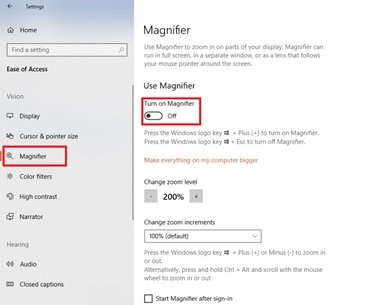
With this feature, you can make the text and other items, like icons, on your screen appear larger without changing the screen resolution of your monitor or laptop screen. This lets you play around with the size of the text or other items on your screen and at the same time keep your monitor or laptop set to its optimal resolution. Magnifier can be very helpful for anyone who has poor eyesight or faces difficulty in reading their screen.
To access this feature, go to the same Ease of Access section in Settings; here’s the path: Settings>Ease of Access>Magnifier. To use Magnifier, activate the ‘Turn on Magnifier’ toggle.
There are several settings available in this feature that allow you to turn the tool on/off, designate what you want to be magnified, and also invert colors in the magnified area. When this feature is enabled, a magnifying glass appears on your screen, and you can easily zoom in or out by clicking on the ‘+’ or ‘-’ icon.
Read: How to Increase the Font size and make text bigger on Windows 10.
2] High Contrast
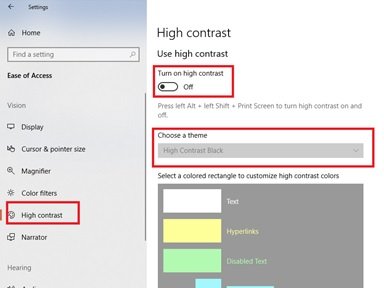
Windows 10 allows you to change the overall color scheme so that it is easier to view text, images, icons, and application windows. The ‘High Contrast’ feature can be amazing for people struggling with visual impairment or colorblindness as it can make the items on the screen appear more distinct and easier to identify.
To pick pre-designated high contrast themes in Windows 10 go to Settings>Ease of Access>High Contrast.
3] Narrator
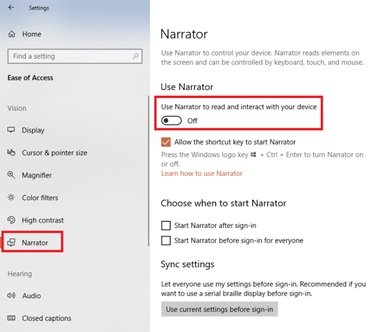
Microsoft named this feature the Narrator because of its incredible function. Narrator is a screen reader who can read the text appearing on the screen aloud. It describes events like error messages, read the text as you type, websites, notifications, in-app content, and specific portions out loud, so the user can use the PC without a display. For the people who are challenged with blindness, color blindness, or low vision issues, this Windows 10 accessibility feature can be of great help.
To get your computer do the talking get Narrator by going to Settings > Ease of Access > Narrator and turn the ‘use narrator to read and interact with your device’ toggle ‘On’.
Read: How to use the Narrator in Windows.
4] Speech Recognition
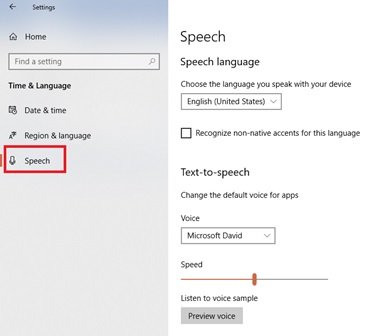
Speech Recognition is another gem in the Window 10 Accessibility Features bucket. This feature allows you to command your PC with your voice–including the competence to navigate menus, dictate into almost any application, surf the web. Also, it listens to your spoken words and translates them into on-screen actions.
You can enable this feature by opening Settings > Time & Language > Speech and scroll down to Dictate text and control your device using only your voice.
Please note: Speech Recognition feature is available only in English (US, UK, Canada, Australia, and India), French, German, Japanese, Mandarin (Chinese Traditional and Chinese Simplified), and Spanish.
5] Closed Captions
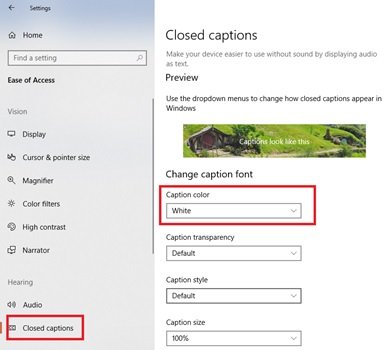
If you fight to read white color subtitles on a video, movie or television show, especially on a light background, the ‘Closed Captions’ feature can be a savior. This feature can help you edit the colors and backgrounds of any caption text.
To access Closed Captions, go to Settings > Ease of Access > Closed Captions and change the settings to your liking.
You can also customize the transparency, size, style, and effects of the caption. A live preview appears at the top of the screen displaying every change you make. Note, these settings will be applied to subtitles across all supported local media players.
6] Mouse
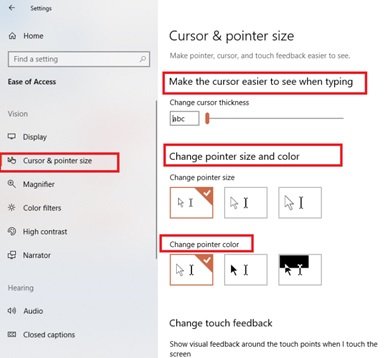
If you find it difficult to spot the mouse pointer on your screen, you can make it more visible with this feature. Yes, you can change the size and color of the mouse pointer appearing on your screen.
To alter the way your mouse pointer looks, go to Settings > Ease of Access > Cursor & Pointer.
Read: How to Change Mouse Pointer color to red, solid black, etc and Adjust Text Cursor Indicator size, color & thickness for better visibility.
7] On-Screen Keyboard
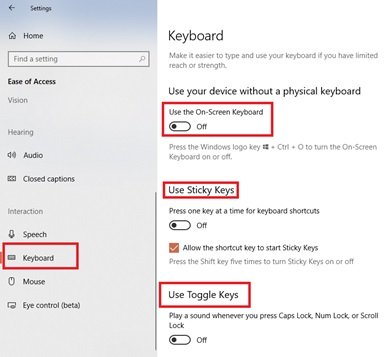
The On-Screen Keyboard displays a visual keyboard on the screen; like the normal keyboard, this one has all the standard keys intact. To use this keyboard, you can use your mouse or any other pointing device. This feature offers a variety of customization options for people with special needs or disabilities which makes the keyboard much easier and comfortable to use. Few amazing mini-features of this accessibility tool are:
- Sticky keys – Ideal for those who find it difficult to maintain finger deftness for a long time. These keys let you press one key at a time for keyboard shortcut combinations like CTRL+ALT+DELETE.
- Filter Keys – This tool will be handy for those who find it difficult to manage their hands on the keyboard. It can check for repeated keystrokes so that the user doesn’t need to use the backspace key every time to go back over what he/she has written.
- Toggle keys – Tells you whether Caps Lock is activated or not. It plays a sound each time you hit the Num Lock, Scroll Lock, or Function Lock keys.
8] Eye Control
Eye Control Feature in Windows 10 lets you access PC with the movement of Eyes. You can use the Eye Control feature in Windows 10. Eye Control can be enabled by going to Settings > Ease of Access > Eye control and selecting Turn on eye control. This will open LaunchPad which is like a control panel from where you can perform various functions like right-click, left-click, task view, and more.
UPDATES:
Improved Screen Reading with Narrator: Microsoft has done a lot of changes with Narrator that come as a part of the Windows 10 Anniversary Update. The updates are:
- Improved text to speech voices: Microsoft has added new voices to Narrator that offer a much faster top rate of speech. The current voices average a maximum of roughly 400 words per minute. The new voices average nearly twice that at approximately 800 words per minute.
- New languages added to Narrator: Now Narrator will come with more languages such as Spanish, French, Portuguese, Arabic, Catalan, Danish, Finnish, Norwegian, Dutch, Swedish, and Turkish.
- The introduction of scan mode: This is the newest addition to the Narrator. Microsoft has added a new navigation mode to Narrator called Scan mode. Scan Mode is turned on with a press of CAPS LOCK and SPACE. While users are in Scan mode, they can press SPACE to activate an item of interest, such as following a link on a web page or pressing a button in an app.
- Six levels of verbosity: The narrator can now support the six levels of verbosity for giving the users more details about the characteristics of the text. They can cycle through these modes by pressing CAPS LOCK + CTRL + (PLUS). For example, at Verbose mode 0 (zero), the user will hear just the text. At verbose mode 1, the user might hear if the text is a heading. Thus, the user can change the verbose mode to know more about the text that is being read by the Narrator.
- Punctuation Modes: Narrator now gives the users more control over how much punctuation they hear when reading the text. CAPS LOCK+ALT+(PLUS) and CAPS LOCK+ALT+(MINUS) cycle through the settings for punctuation. The settings for punctuation include none, some, most, all and math along with the default.
Besides these, Narrator has got some more features such as more familiar keyboard navigation, announcing AutoSuggest results and easy to send feedback to the Microsoft team. To make the usage of Narrator easy Microsoft’s team is working hard on user guides and documentation. The user guides will be available online when the Anniversary Update is released.
Apps and experiences made more accessible: Microsoft’s team not only has worked upon Narrator, but they have also worked on making the apps and experiences more accessible. Some of these accessibility improvements in Windows 10 are as follows:
- Microsoft Edge becomes more accessible in browsing and reading: Microsoft Edge team has already provided a number of updates on their accessibility progress. Some of these updates were made to help developers more easily build accessible sites. The team has also been working closely with the most popular third-party assistive technology vendors to guide them through the transition to this new platform.
- Mail: The Windows 10 Anniversary Update has a significant change in the Mail app. Since the initial release of Windows 10 last summer, there have been many improvements to the accessibility of the Mail app.
- Cortana: Cortana proved to be the best assistance when it comes to accessibility provided to people with disabilities. Users can more reliably operate search and Cortana with the keyboard, including things like navigating using arrow keys and tab order.
Windows 10 brings meaningful innovation to all people’s lives, whether you have a disability, a personal penchant, or an exclusive work style. With this robust set of built-in Windows 10 accessibility features, Microsoft allows you to choose how to interact with your screen, express ideas – ultimately get your work done.

Leave a Reply